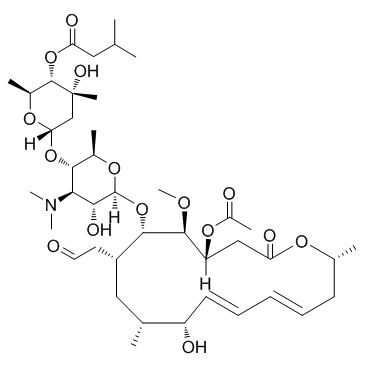Josamycin (EN-141) (Synonyms: Kitasamycin A3, Leucomycin A3, Turimycin A5) |
| Catalog No.GC32108 |
Josamycin (EN-141) (EN-141) is a macrolide antibiotic exhibiting antimicrobial activity against a wide spectrum of pathogens, such as bacteria.
Products are for research use only. Not for human use. We do not sell to patients.

Cas No.: 16846-24-5
Sample solution is provided at 25 µL, 10mM.
Josamycin (EN-141) is a macrolide antibiotic exhibiting antimicrobial activity against a wide spectrum of pathogens, such as bacteria. The dissociation constant Kd from ribosome for Josamycin is 5.5 nM.
Studies show that the average lifetime on the ribosome is 3 h for Josamycin and that the dissociation constants for Josamycin binding to the ribosome is 5.5 nM. Josamycin slows down formation of the first peptide bond of a nascent peptide in an amino acid-dependent way and completely inhibits formation of the second or third peptide bond, depending on peptide sequence at a saturating drug concentration, synthesis of fulllength proteins is completely shut down by Josamycin. At a saturating drug concentration, synthesis of fulllength proteins is completely shut down by Josamycin[1].
Blood and tissue levels of Josamycin after oral administration are 200 mg/kg to rabbits. Tissue levels are generally much higher than the blood levels, and 3 h after the administration, when the blood level is very low, the tissue levels are rather higher than those 1 h after the dose. One hour after the medication, the level in the lungs is the highest of all the tissue levels[2].
[1]. Lovmar M, et al. Kinetics of macrolide action: the Josamycin and erythromycin cases. J Biol Chem. 2004 Dec 17;279(51):53506-15. [2]. Osono T, et al. Pharmacokinetics of macrolides, lincosamides and streptogramins. J Antimicrob Chemother. 1985 Jul;16 Suppl A:151-66.
Average Rating: 5 (Based on Reviews and 22 reference(s) in Google Scholar.)
GLPBIO products are for RESEARCH USE ONLY. Please make sure your review or question is research based.
Required fields are marked with *




















